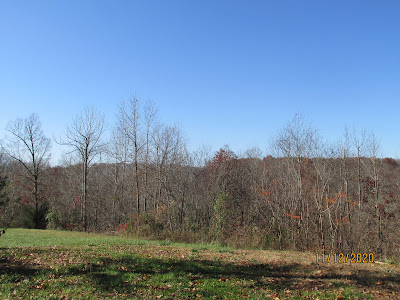Waking early in the morning, if I turn on my pillow toward the west window, the tallest tree in the group at the end of the field is centered on the window.
Yet if I go outside and stand below the window, the tree is off to the left. Perhaps the fact that I earned a barely passing grade decades ago in plane geometry has something to do with my puzzlement about angles, both real and perceived.
For several weeks the sun edging around the barn at an ever more southern cant set the top of the tree aglow with a gold/bronze light.
The gentle intermittent rain and accompanying wind which began on Tuesday evening and continued through Wednesday stripped many of the remaining leaves which now lie in deep ruffs on the lane and the grass verges.
The oaks cling to their leaves still and the ash as well.
Near the north west property boundary.
Burning Bush [Euonymous alatus] has naturalized in Kentucky to the point of being considered an invasive pest. When I first recognized them growing here and there along the ravine edges I was surprised. I can forgive their invasive habit for the sake of the brilliant fall color.
A blackberry briar nearly as brilliant as the burning bush.
The concrete slab where we parked our 5th wheel camper while building the house is visible to the right behind this oak. I hadn't previously noticed how the tree trunk is scarred, perhaps from wire fencing.
Hardware imbedded in the trunk.
The north-facing side of the tree is damaged--perhaps from proximity to the fire [of suspicious origins] that leveled the former owners' house.
Several dandelions glowed against the drab shades of fallen leaves.
At the edge of the south ravine a scrubby oak sapling sports scarlet leaves--strange coloring for an oak.
Strolling slowly back to the house I stopped to assess the results of my weeding and mulching. I've done nothing with the lavender but let it grow against the angle of the raised bed.
Several of the thymes raised from seed have flourished beneath the window of the guest bedroom on the lower level. Several planted to the left of the window failed to thrive, swallowed by the Mexican torch flowers which sprawled out of bounds.
One last coneflower, edges frost-frayed while in bud.
Lady's Mantle--one of only two plants which survived from seed, mulched and
hopefully secure for the winter.
On the east porch--the surprise of a rust-red nasturtium beside the yellow ones--a seedling from an earlier flowering.
The coneflower loaded twice and I don't see a 'remove' option with the new format.
















Obviously, you, like me, admire those trees and shrubs that bear red foliage. Hopefully, the little oak will continue to be beautiful every year. You already have a great start on next year's perennials.
ReplyDeleteMary; I miss the red colors of sugar maples in fall--having been born and lived in New England for most of my life. Different trees prevail here but we are so blessed to live in the country with acreage around us as a buffer.
ReplyDeleteLadies Mantle in my garden is an absolute pest, and I shall think twice before growing Mourning Widow (Cranesbill) again as THAT is also very invasive, even if it IS beloved of the bees.
ReplyDeleteYour plot is lovely, and I hope that the things you want to survive the winter, will. Lovely fall reds in those plants.
Jennie; Lady's Mantle, which I really like, has never spread aggressively for me. It took hard winters in my Vermont garden, doesn't seem to like the hot humid summers of Kentucky. These are the only two plants from seed that survived to a size where they could be set out. I'm hoping they thrive--but not holding my breath!
Delete